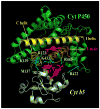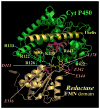The interaction of microsomal cytochrome P450 2B4 with its redox partners, cytochrome P450 reductase and cytochrome b(5)
- PMID: 21055385
- PMCID: PMC3073529
- DOI: 10.1016/j.abb.2010.10.023
The interaction of microsomal cytochrome P450 2B4 with its redox partners, cytochrome P450 reductase and cytochrome b(5)
Abstract
Cytochrome P450 2B4 is a microsomal protein with a multi-step reaction cycle similar to that observed in the majority of other cytochromes P450. The cytochrome P450 2B4-substrate complex is reduced from the ferric to the ferrous form by cytochrome P450 reductase. After binding oxygen, the oxyferrous protein accepts a second electron which is provided by either cytochrome P450 reductase or cytochrome b(5). In both instances, product formation occurs. When the second electron is donated by cytochrome b(5), catalysis (product formation) is ∼10- to 100-fold faster than in the presence of cytochrome P450 reductase. This allows less time for side product formation (hydrogen peroxide and superoxide) and improves by ∼15% the coupling of NADPH consumption to product formation. Cytochrome b(5) has also been shown to compete with cytochrome P450 reductase for a binding site on the proximal surface of cytochrome P450 2B4. These two different effects of cytochrome b(5) on cytochrome P450 2B4 reactivity can explain how cytochrome b(5) is able to stimulate, inhibit, or have no effect on cytochrome P450 2B4 activity. At low molar ratios (<1) of cytochrome b(5) to cytochrome P450 reductase, the more rapid catalysis results in enhanced substrate metabolism. In contrast, at high molar ratios (>1) of cytochrome b(5) to cytochrome P450 reductase, cytochrome b(5) inhibits activity by binding to the proximal surface of cytochrome P450 and preventing the reductase from reducing ferric cytochrome P450 to the ferrous protein, thereby aborting the catalytic reaction cycle. When the stimulatory and inhibitory effects of cytochrome b(5) are equal, it will appear to have no effect on the enzymatic activity. It is hypothesized that cytochrome b(5) stimulates catalysis by causing a conformational change in the active site, which allows the active oxidizing oxyferryl species of cytochrome P450 to be formed more rapidly than in the presence of reductase.
Copyright © 2010 Elsevier Inc. All rights reserved.
Figures







 , product formation by P450-b5; , product formation by P450-b5; |  , product formation by P450-CPR; , product formation by P450-CPR; |
 , ΔA438nm for P450-b5; , ΔA438nm for P450-b5; |  , ΔA438nm for P450-CPR. , ΔA438nm for P450-CPR. |
Similar articles
-
Protonation of the Hydroperoxo Intermediate of Cytochrome P450 2B4 Is Slower in the Presence of Cytochrome P450 Reductase Than in the Presence of Cytochrome b5.Biochemistry. 2016 Nov 29;55(47):6558-6567. doi: 10.1021/acs.biochem.6b00996. Epub 2016 Nov 8. Biochemistry. 2016. PMID: 27797496
-
Cytochrome b5 increases the rate of product formation by cytochrome P450 2B4 and competes with cytochrome P450 reductase for a binding site on cytochrome P450 2B4.J Biol Chem. 2007 Oct 12;282(41):29766-76. doi: 10.1074/jbc.M703845200. Epub 2007 Aug 10. J Biol Chem. 2007. PMID: 17693640
-
Cytochrome b5 inhibits electron transfer from NADPH-cytochrome P450 reductase to ferric cytochrome P450 2B4.J Biol Chem. 2008 Feb 29;283(9):5217-25. doi: 10.1074/jbc.M709094200. Epub 2007 Dec 17. J Biol Chem. 2008. PMID: 18086668
-
Role of cytochrome b5 in catalysis by cytochrome P450 2B4.Biochem Biophys Res Commun. 2005 Dec 9;338(1):499-506. doi: 10.1016/j.bbrc.2005.09.022. Epub 2005 Sep 15. Biochem Biophys Res Commun. 2005. PMID: 16182240 Review.
-
The many roles of cytochrome b5.Pharmacol Ther. 2003 Feb;97(2):139-52. doi: 10.1016/s0163-7258(02)00327-3. Pharmacol Ther. 2003. PMID: 12559387 Review.
Cited by
-
Effect of Cytochrome b5 Content on the Activity of Polymorphic CYP1A2, 2B6, and 2E1 in Human Liver Microsomes.PLoS One. 2015 Jun 5;10(6):e0128547. doi: 10.1371/journal.pone.0128547. eCollection 2015. PLoS One. 2015. PMID: 26046844 Free PMC article.
-
Cross-linking mass spectrometry and mutagenesis confirm the functional importance of surface interactions between CYP3A4 and holo/apo cytochrome b(5).Biochemistry. 2012 Nov 27;51(47):9488-500. doi: 10.1021/bi301069r. Epub 2012 Nov 14. Biochemistry. 2012. PMID: 23150942 Free PMC article.
-
Direct interaction between the transmembrane helices stabilize cytochrome P450 2B4 and cytochrome b5 redox complex.Biophys Chem. 2023 Oct;301:107092. doi: 10.1016/j.bpc.2023.107092. Epub 2023 Aug 8. Biophys Chem. 2023. PMID: 37586236 Free PMC article.
-
Substrate mediated redox partner selectivity of cytochrome P450.Chem Commun (Camb). 2018 May 31;54(45):5780-5783. doi: 10.1039/c8cc02525h. Chem Commun (Camb). 2018. PMID: 29781479 Free PMC article.
-
Correlating structure and function of drug-metabolizing enzymes: progress and ongoing challenges.Drug Metab Dispos. 2014 Jan;42(1):9-22. doi: 10.1124/dmd.113.054627. Epub 2013 Oct 15. Drug Metab Dispos. 2014. PMID: 24130370 Free PMC article. Review.
References
-
- Ortiz de Montellano PR. Cytochrome P450: structure, mechanism, and biochemistry. Kluwer Academic/Plenum Publishers; New York, New York: 2005.
-
- Shaik S, Cohen Y, Wang HC, Kumar D, Thiel W. P450 Enzymes: Their Structure, Reactivity and Selectivity, Modeled by QM/MM Calculations. Chem Rev. 2010;110:949. - PubMed
-
- Paine MJ, Scrutton NS, Munro AW, Gutierrez A, Roberts GCK, Wolf CR. In: Cytochrome P450. 3rd. Ortiz de Montellano PR, editor. Kluwer Academic/Plenum Publishers; New York, Boston, Dordrecht, London, Moscow: 2005. pp. 115–148.
-
- Schenkman JB, Jansson I. The many roles of cytochrome b5. Pharmacol Ther. 2003;97:139–152. - PubMed
Publication types
MeSH terms
Substances
Grants and funding
LinkOut - more resources
Full Text Sources

